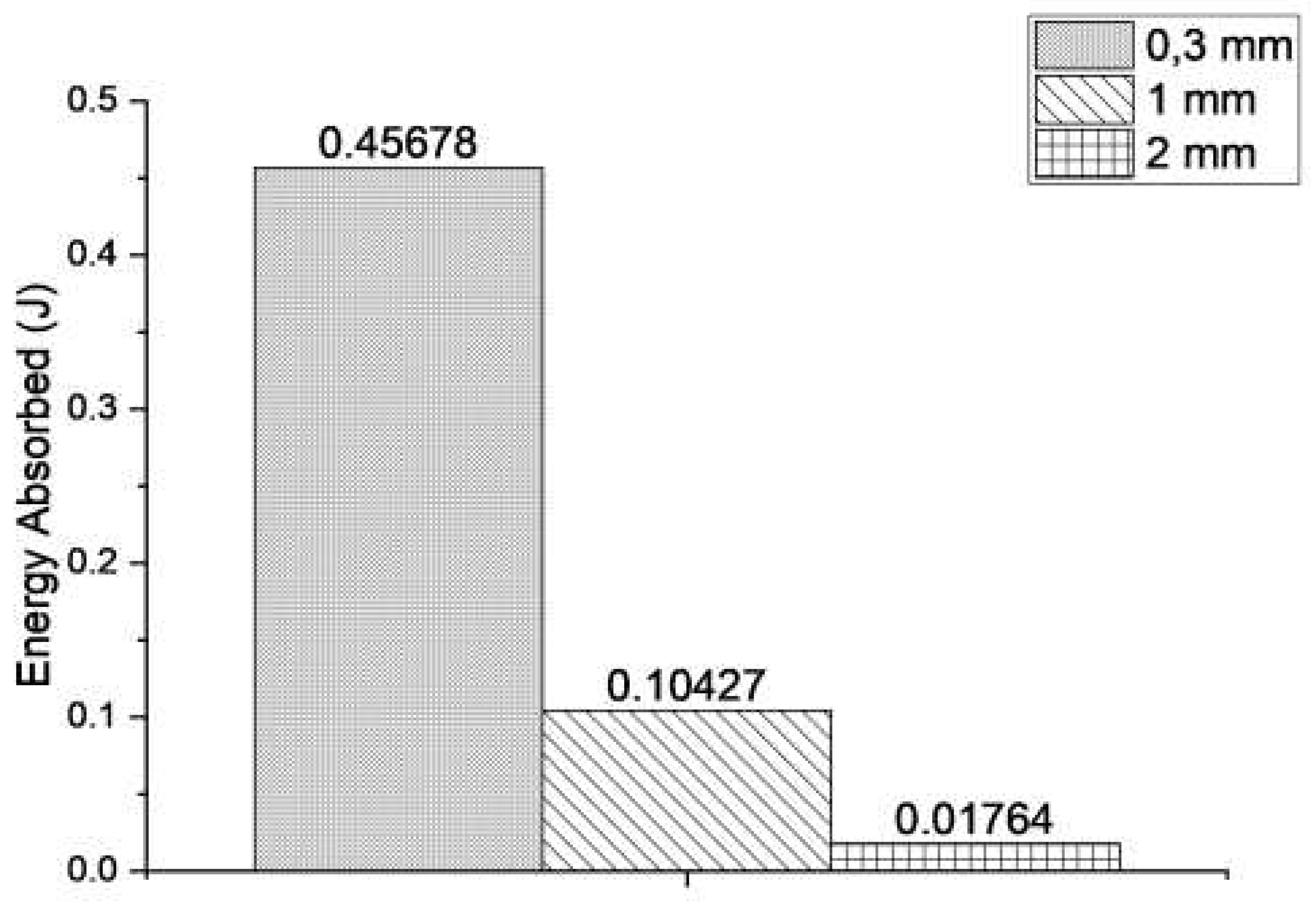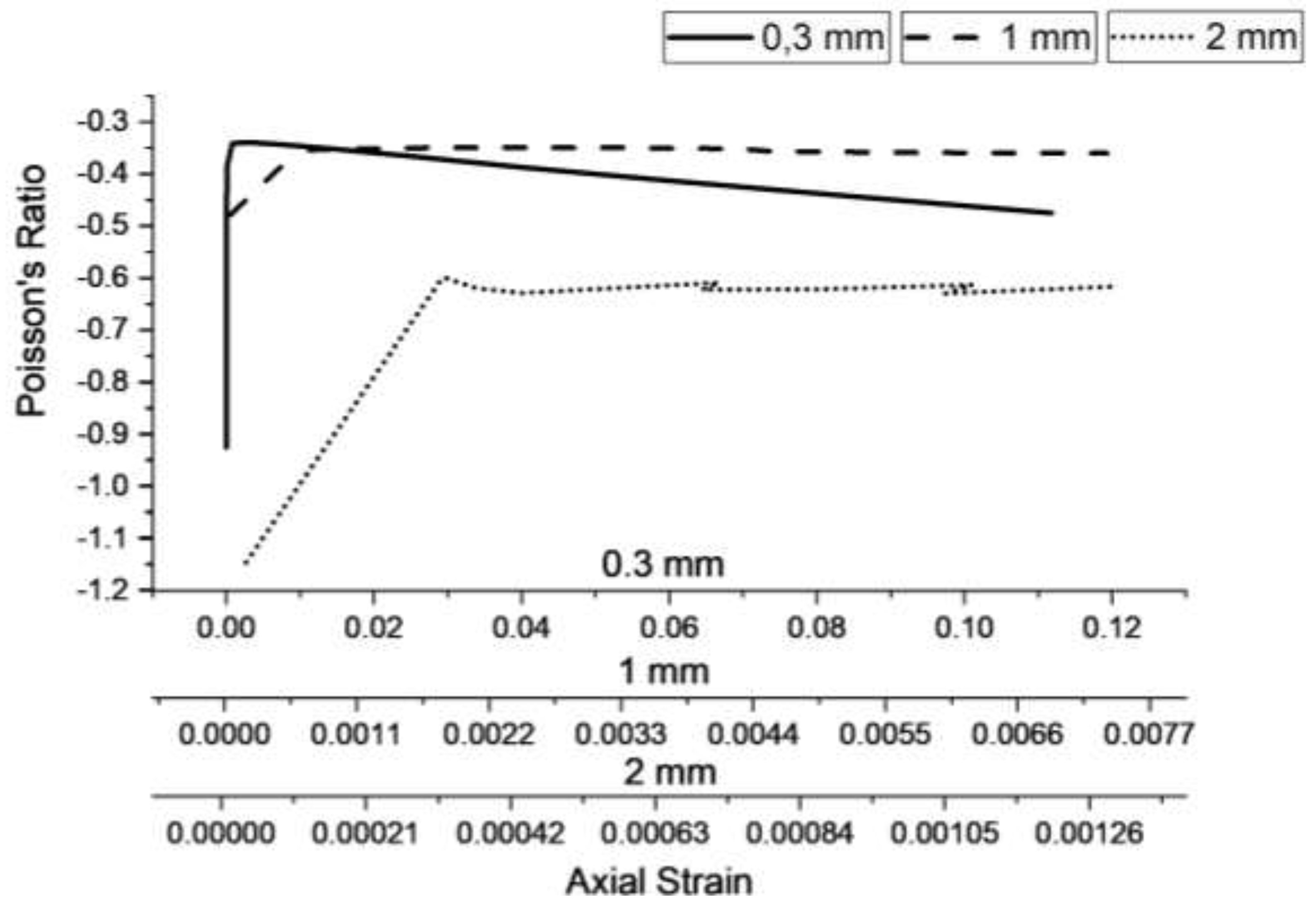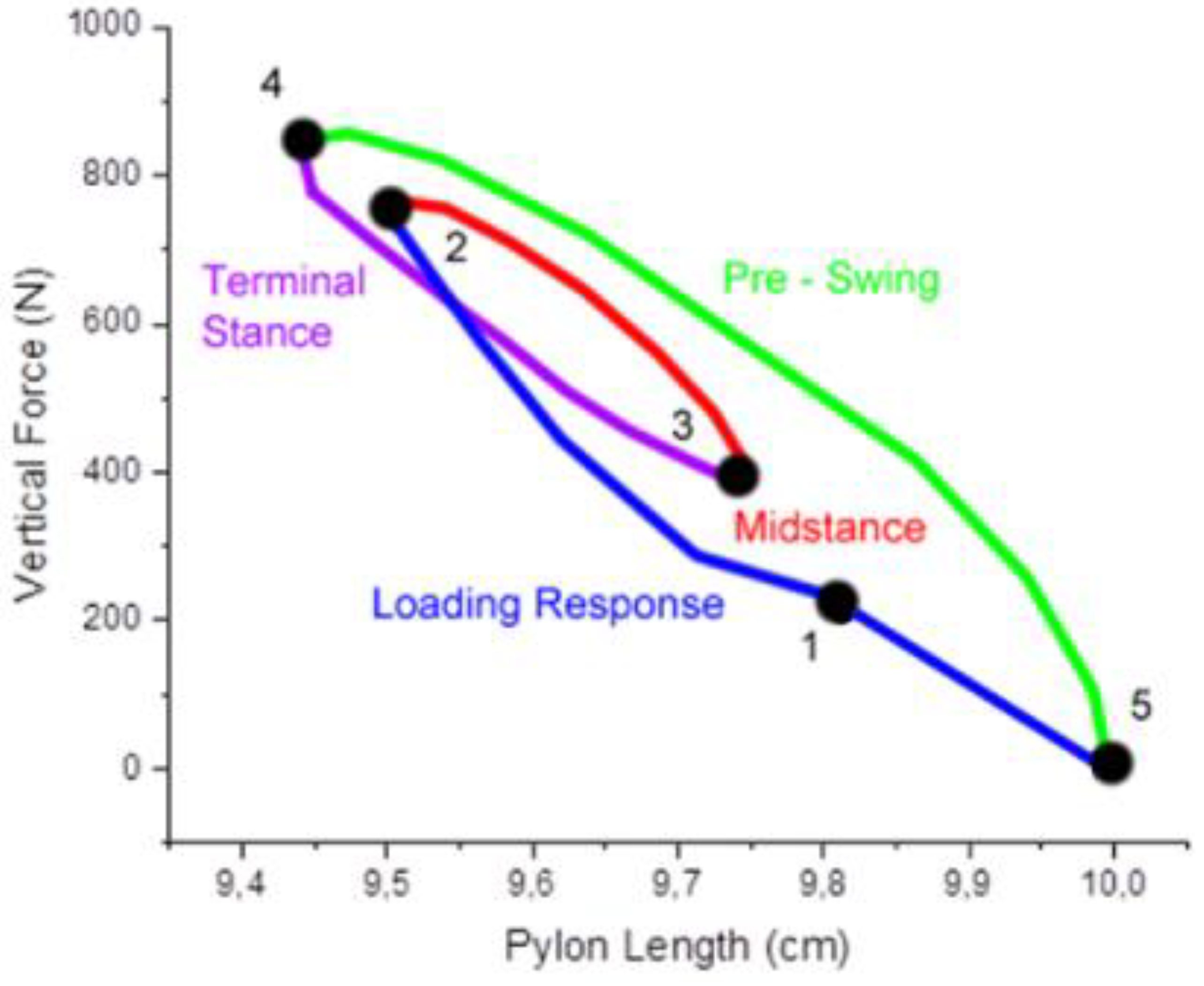Submitted:
13 February 2024
Posted:
13 February 2024
You are already at the latest version
Abstract
Keywords:
1. Introduction
2. Materials and Methods
2.1. Pylon Design
2.2. Material Consideration
2.3. Experimental Validation
2.4. Simulation Procedure
2.5. Case Definition
3. Results & Discussion
3.1. Experimental validation
3.2. Body weight case
3.3. Gait simulation case
4. Conclusions
Author Contributions
Data Availability Statement
Acknowledgments
Conflicts of Interest
References
- Cipriani, C.; Controzzi, M.; Carrozza, M.C. Progress towards the Development of the SmartHand Transradial Prosthesis. 2009 IEEE International Conference on Rehabilitation Robotics 2009. [CrossRef]
- Herr, H.M.; Grabowski, A.M. Bionic Ankle–Foot Prosthesis Normalizes Walking Gait for Persons with Leg Amputation. Proceedings of the Royal Society B: Biological Sciences 2011, 279, 457–464. [CrossRef]
- Aziz, S.A.A.; Ubaidillah; Mazlan, S.A.; Ismail, N.I.N.; Choi, S.-B. Implementation of Functionalized Multiwall Carbon Nanotubes on Magnetorheological Elastomer. Journal of Materials Science 2018, 53, 10122–10134. [CrossRef]
- Pokaad, A.Z.B.; Hudha, K.; Nasir, M.Z.B.M.; Ubaidillah, N.A. Simulation and Experimental Studies on the Behaviour of a Magnetorheological Damper under Impact Loading. International Journal of Structural Engineering 2011, 2, 164. [CrossRef]
- Imaduddin, F.; Mazlan, S.A.; Ubaidillah; Zamzuri, H.; Fatah, A.Y.A. Testing and Parametric Modeling of Magnetorheological Valve with Meandering Flow Path. Nonlinear Dynamics 2016, 85, 287–302. [CrossRef]
- Wirawan, J.W., Ubaidillah, U., Lenggana, B.W., Purnomo, E.D., Widyarso, W. and Mazlan, S.A., 2019. Design and performance analysis of magnetorheological valve for upside-down damper. Journal of Advanced Research in Fluid Mechanics and Thermal Sciences, 63(2), pp.164-173.Maun, J.A.; Gard, S.A.; Major, M.J.; Takahashi, K.Z. Reducing Stiffness of Shock-Absorbing Pylon Amplifies Prosthesis Energy Loss and Redistributes Joint Mechanical Work during Walking. Journal of NeuroEngineering and Rehabilitation 2021, 18. [CrossRef]
- Rakbangboon, T.; Guerra, G.; Kla-arsa, S.; Padungjaroen, U.; Tangpornprasert, P.; Virulsri, C.; Sasaki, K. High-Level Mobility of Trans-Tibial Prosthesis Users Wearing Commercial and sPace Energy-Storing Prosthetic Feet. International Journal of Environmental Research and Public Health 2022, 19, 12606. [CrossRef]
- Radcliffe, C.W. Four-Bar Linkage Prosthetic Knee Mechanisms. Prosthetics & Orthotics International 1994, 18, 159–173. [CrossRef]
- Houdijk, H.; Wezenberg, D.; Hak, L.; Cutti, A.G. Energy Storing and Return Prosthetic Feet Improve Step Length Symmetry While Preserving Margins of Stability in Persons with Transtibial Amputation. Journal of NeuroEngineering and Rehabilitation 2018, 15. [CrossRef]
- Kowalczyk, M. & Jopek, H. Numerical analysis of the lower limb prosthesis subjected to various load conditions. Vibrations in Physical Systems 2020 31.
- Fardan, M.F.; Lenggana, B.W.; Ubaidillah, U.; Choi, S.-B.; Susilo, D.D.; Khan, S.Z. Revolutionizing Prosthetic Design with Auxetic Metamaterials and Structures: A Review of Mechanical Properties and Limitations. Micromachines 2023, 14, 1165. [CrossRef]
- Lees, C.; Vincent, J.F.V.; Hillerton, J.E. Poisson’s Ratio in Skin. Bio-Medical Materials and Engineering 1991, 1, 19–23. [CrossRef]
- Pendry, J.B. Negative Refraction Makes a Perfect Lens. Physical Review Letters 2000, 85, 3966–3969. [CrossRef]
- Pendry, J.B.; Holden, A.J.; Stewart, W.J.; Youngs, I. Extremely Low Frequency Plasmons in Metallic Mesostructures. Physical Review Letters 1996, 76, 4773–4776. [CrossRef]
- Narayana, S.; Sato, Y. Heat Flux Manipulation with Engineered Thermal Materials. Physical Review Letters 2012, 108. [CrossRef]
- Liu, Z.; Zhang, X.; Mao, Y.; Zhu, Y.Y.; Yang, Z.; Chan, C.T.; Sheng, P. Locally Resonant Sonic Materials. Science 2000, 289, 1734–1736. [CrossRef]
- Beer, F. P., Johnston, R., Dewolf, J. & Mazurek, D. Mechanics of Materials, McGraw-Hill. New York 2013.
- Lakes, R. Foam Structures with a Negative Poisson’s Ratio. Science 1987 235, 1038–1040.
- Qi, C.; Remennikov, A.; Pei, L.-Z.; Yang, S.; Yu, Z.-H.; Ngo, T.D. Impact and Close-in Blast Response of Auxetic Honeycomb-Cored Sandwich Panels: Experimental Tests and Numerical Simulations. Composite Structures 2017, 180, 161–178. [CrossRef]
- Mark, A.G.; Palagi, S.; Qiu, T.; Fischer, P. Auxetic Metamaterial Simplifies Soft Robot Design. 2016 IEEE International Conference on Robotics and Automation (ICRA) 2016. [CrossRef]
- Kim, H.-S.; Um, H.-J.; Hong, W.; Kim, H.-S.; Hur, P. Structural Design for Energy Absorption during Heel Strike Using the Auxetic Structure in the Heel Part of the Prosthetic Foot. 2021 18th International Conference on Ubiquitous Robots (UR) 2021. [CrossRef]
- Yang, H.; Wang, B.; Ma, L. Mechanical Properties of 3D Double-U Auxetic Structures. International Journal of Solids and Structures 2019, 180–181, 13–29. [CrossRef]
- Li, X.; Wang, Q.; Yang, Z.; Lu, Z. Novel Auxetic Structures with Enhanced Mechanical Properties. Extreme Mechanics Letters 2019, 27, 59–65. [CrossRef]
- Bodaghi, M.; Serjouei, A.; Zolfagharian, A.; Fotouhi, M.; Rahman, H.; Durand, D. Reversible Energy Absorbing Meta-Sandwiches by FDM 4D Printing. International Journal of Mechanical Sciences 2020, 173, 105451. [CrossRef]
- Yang, W.; Huang, R.; Liu, J.; Liu, J.; Huang, W. Ballistic Impact Responses and Failure Mechanism of Composite Double-Arrow Auxetic Structure. Thin-Walled Structures 2022, 174, 109087. [CrossRef]
- Um, H.-J.; Kim, H.-S.; Hong, W.; Kim, H.-S.; Hur, P. Design of 3D Printable Prosthetic Foot to Implement Nonlinear Stiffness Behavior of Human Toe Joint Based on Finite Element Analysis. Scientific Reports 2021, 11. [CrossRef]
- Mirzaali, M.J.; Janbaz, S.; Strano, M.; Vergani, L.; Zadpoor, A.A. Shape-Matching Soft Mechanical Metamaterials. Scientific Reports 2018, 8. [CrossRef]
- Zamani, M.H.; Heidari-Rarani, M.; Torabi, K. Optimal Design of a Novel Graded Auxetic Honeycomb Core for Sandwich Beams under Bending Using Digital Image Correlation (DIC). Composite Structures 2022, 286, 115310. [CrossRef]
- Yang, L.; Harrysson, O.; West, H.; Cormier, D. Mechanical Properties of 3D Re-Entrant Honeycomb Auxetic Structures Realized via Additive Manufacturing. International Journal of Solids and Structures 2015, 69–70, 475–490. [CrossRef]
- Reverte, J.M.; Caminero, M.Á.; Chacón, J.M.; García-Plaza, E.; Núñez, P.J.; Becar, J.P. Mechanical and Geometric Performance of PLA-Based Polymer Composites Processed by the Fused Filament Fabrication Additive Manufacturing Technique. Materials 2020, 13, 1924. [CrossRef]
- Hazimi, H.; Ubaidillah, U.; Alnursyah, R.; Nursya’bani, H.; Lenggana, B.W.; Wibowo Improvement of Space Tube Frame for Formula Student Vehicle. Proceedings of the 6th International Conference and Exhibition on Sustainable Energy and Advanced Materials 2020, 735–744. [CrossRef]
- Gard, S.A.; Konz, R.J. The Effect of a Shock-Absorbing Pylon on the Gait of Persons with Unilateral Transtibial Amputation. The Journal of Rehabilitation Research and Development 2003, 40, 111. [CrossRef]



















| Mechanical Properties | Parameters |
|---|---|
| Density (g/cm3) | 1.24 |
| Young’s Modulus (MPa) | 3420 |
| Poisson’s ratio | 0.3 |
| Elongation at break (%) | 4.2 |
| Mechanical Properties | Parameters |
|---|---|
| Young’s modulus (GPa) | 208 |
| Yield strength (MPa) | 1240 |
| Element Size | Number of Elements | Max. Displacement |
|---|---|---|
| 1 | 5262 | -4.407 |
| 0.9 | 5982 | -4.4889 |
| 0.8 | 6910 | -4.4977 |
| 0.7 | 7966 | -4.4789 |
| 0.6 | 9582 | -4.4755 |
| 0.5 | 11742 | -4.4827 |
| 0.4 | 17038 | -4.474 |
| 0.3 | 27310 | -4.472 |
| Ligament Thickness (mm) | Stiffness Coefficient (kN/m) | |
|---|---|---|
| System | Individual Ligament | |
| 0.3 | 79.24 | 9.9 |
| 1 | 2,371.6 | 296.45 |
| 2 | 13,344 | 1,668 |
Disclaimer/Publisher’s Note: The statements, opinions and data contained in all publications are solely those of the individual author(s) and contributor(s) and not of MDPI and/or the editor(s). MDPI and/or the editor(s) disclaim responsibility for any injury to people or property resulting from any ideas, methods, instructions or products referred to in the content. |
© 2024 by the authors. Licensee MDPI, Basel, Switzerland. This article is an open access article distributed under the terms and conditions of the Creative Commons Attribution (CC BY) license (http://creativecommons.org/licenses/by/4.0/).





